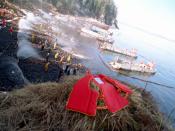1. What was the basis for the crisis?
The basis for the crisis was that Exxon really didn't have an emergency plan for a spill that near to shore. They were more concerned with losing tankers at sea.
"The company must do well solving the actual problem - in this case, cleaning up 10 million gallons of spilled oil. And the company must create a positive perception of how the problem is handled." (Elliott, 1989)
2. Were there any policy decisions that led to the crisis?
This depends on whether you see the cause as a policy decision by Exxon or an accident caused by their employee Captain Joseph Hazlewood, He admits to consuming at least three drinks before boarding the ship that day. He was acquitted though on charges of operating the tanker while drunk. He was however convicted with a misdemeanor offense of illegally discharging oil.
3. How was the crisis managed?
Compared to the negligence that led to the actual spill, the clean-up of the crisis was handled surprisingly quickly. The NOAA deployed a team of scientists that predicted the trajectory and distance of the oil spills. The data gathered from their calculations was used by Coast Guard and Exxon crew members to clean up the spills. Exxon paid for several methods of cleanup. A small oil-burning campaign was instituted and, after a few successful results, it was discontinued due to inclement weather. Also, mechanical skimmers tried to remove the oil, and succeeded partially before the equipment was clogged. Many gallons of oil were also transferred into temporary storage facilities while Exxon supported the use of a dispersal agent.
Over the long term, Congress passed the Oil Pollution Act of 1990 and the EVOS (Exxon Valdez Oil Spill) Trustee Council was also established to...


